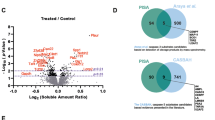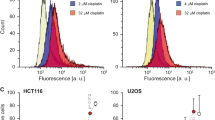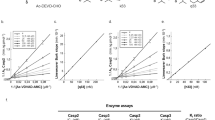Abstract
Caspases are a family of proteases found in all metazoans, including a dozen in humans, that drive the terminal stages of apoptosis as well as other cellular remodeling and inflammatory events. Caspases are named because they are cysteine class enzymes shown to cleave after aspartate residues. In the past decade, we and others have developed unbiased proteomic methods that collectively identified ~2000 native proteins cleaved during apoptosis after the signature aspartate residues. Here, we explore non-aspartate cleavage events and identify 100s of substrates cleaved after glutamate in both human and murine apoptotic samples. The extended consensus sequence patterns are virtually identical for the aspartate and glutamate cleavage sites suggesting they are cleaved by the same caspases. Detailed kinetic analyses of the dominant apoptotic executioner caspases-3 and -7 show that synthetic substrates containing DEVD↓ are cleaved only twofold faster than DEVE↓, which is well within the 500-fold range of rates that natural proteins are cut. X-ray crystallography studies confirm that the two acidic substrates bind in virtually the same way to either caspases-3 or -7 with minimal adjustments to accommodate the larger glutamate. Lastly, during apoptosis we found 121 proteins cleaved after serine residues that have been previously annotated to be phosphorylation sites. We found that caspase-3, but not caspase-7, can cleave peptides containing DEVpS↓ at only threefold slower rate than DEVD↓, but does not cleave the unphosphorylated serine peptide. There are only a handful of previously reported examples of proteins cleaved after glutamate and none after phosphorserine. Our studies reveal a much greater promiscuity for cleaving after acidic residues and the name 'cacidase' could aptly reflect this broader specificity.
Similar content being viewed by others
Log in or create a free account to read this content
Gain free access to this article, as well as selected content from this journal and more on nature.com
or
Abbreviations
- AFC:
-
7-amino-4-timethylfluoro-coumarin
- Ac:
-
acetyl
- Cmk:
-
chloromethylketone
- DNP:
-
dinitrophenol
- DTT:
-
dithiothreitol
- EDTA:
-
ethylenediaminetetraacetic acid
- HEPES:
-
2-[4-(2-hydroxyethyl)piperazin-1-yl]ethanesulfonic acid
- FBS:
-
fetal bovine serum
- Fmk:
-
fluormethylketone
- GO:
-
gene ontology
- RMSD:
-
root mean square deviation
- SDS:
-
sodium dodecyl sulfate
- PBS:
-
phosphate-buffered saline
References
Alnemri ES, Livingston DJ, Nicholson DW, Salvesen G, Thornberry NA, Wong WW et al. Human ICE/CED-3 protease nomenclature. Cell 1996; 87: 171.
Schechter I, Berger A . On the size of the active site in proteases. I. Papain. Biochem Biophys Res Commun 1967; 27: 157–162.
Thornberry NA, Rano TA, Peterson EP, Rasper DM, Timkey T, Garcia-Calvo M et al. A combinatorial approach defines specificities of members of the caspase family and granzyme B. Functional relationships established for key mediators of apoptosis. J Biol Chem 1997; 272: 17907–17911.
Poreba M, Strozyk A, Salvesen GS, Drag M . Caspase substrates and inhibitors. Cold Spring Harb Perspect Biol 2013; 5: a008680.
Rano TA, Timkey T, Peterson EP, Rotonda J, Nicholson DW, Becker JW et al. A combinatorial approach for determining protease specificities: application to interleukin-1beta converting enzyme (ICE). Chem Biol 1997; 4: 149–155.
Pham VC, Anania VG, Phung QT, Lill JR . Complementary methods for the identification of substrates of proteolysis. Methods Enzymol 2014; 544: 359–380.
van den Berg BH, Tholey A . Mass spectrometry-based proteomics strategies for protease cleavage site identification. Proteomics 2012; 12: 516–529.
Staes A, Impens F, Van Damme P, Ruttens B, Goethals M, Demol H et al. Selecting protein N-terminal peptides by combined fractional diagonal chromatography. Nat Protoc 2011; 6: 1130–1141.
Impens F, Colaert N, Helsens K, Ghesquiere B, Timmerman E, De Bock PJ et al. A quantitative proteomics design for systematic identification of protease cleavage events. Mol Cell Proteomics 2010; 9: 2327–2333.
Drag M, Bogyo M, Ellman JA, Salvesen GS . Aminopeptidase fingerprints, an integrated approach for identification of good substrates and optimal inhibitors. J Biol Chem 2010; 285: 3310–3318.
Wejda M, Impens F, Takahashi N, Van Damme P, Gevaert K, Vandenabeele P . Degradomics reveals that cleavage specificity profiles of caspase-2 and effector caspases are alike. J Biol Chem 2012; 287: 33983–33995.
Turowec JP, Zukowski SA, Knight JD, Smalley DM, Graves LM, Johnson GL et al. An unbiased proteomic screen reveals caspase cleavage is positively and negatively regulated by substrate phosphorylation. Mol Cell Proteomics 2014; 13: 1184–1197.
Dix MM, Simon GM, Cravatt BF . Global identification of caspase substrates using PROTOMAP (protein topography and migration analysis platform). Methods Mol Biol 2014; 1133: 61–70.
Julien O, Zhuang M, Wiita AP, O'Donoghue AJ, Knudsen GM, Craik CS et al. Quantitative MS-based enzymology of caspases reveals distinct protein substrate specificities, hierarchies, and cellular roles. Proc Natl Acad Sci USA 2016; 113: E2001–E2010.
Stoehr G, Schaab C, Graumann J, Mann M . A SILAC-based approach identifies substrates of caspase-dependent cleavage upon TRAIL-induced apoptosis. Mol Cell Proteomics 2013; 12: 1436–1450.
Shimbo K, Hsu GW, Nguyen H, Mahrus S, Trinidad JC, Burlingame AL et al. Quantitative profiling of caspase-cleaved substrates reveals different drug-induced and cell-type patterns in apoptosis. Proc Natl Acad Sci USA 2012; 109: 12432–12437.
Lamkanfi M, Kanneganti TD, Van Damme P, Vanden Berghe T, Vanoverberghe I, Vandekerckhove J et al. Targeted peptidecentric proteomics reveals caspase-7 as a substrate of the caspase-1 inflammasomes. Mol Cell Proteomics 2008; 7: 2350–2363.
Crawford ED, Seaman JE, Agard N, Hsu GW, Julien O, Mahrus S et al. The DegraBase: a database of proteolysis in healthy and apoptotic human cells. Mol Cell Proteomics 2013; 12: 813–824.
Mahrus S, Trinidad JC, Barkan DT, Sali A, Burlingame AL, Wells JA . Global sequencing of proteolytic cleavage sites in apoptosis by specific labeling of protein N termini. Cell 2008; 134: 866–876.
Timmer JC, Zhu W, Pop C, Regan T, Snipas SJ, Eroshkin AM et al. Structural and kinetic determinants of protease substrates. Nat Struct Mol Biol 2009; 16: 1101–1108.
Agard NJ, Mahrus S, Trinidad JC, Lynn A, Burlingame AL, Wells JA . Global kinetic analysis of proteolysis via quantitative targeted proteomics. Proc Natl Acad Sci USA 2012; 109: 1913–1918.
Srinivasula SM, Hegde R, Saleh A, Datta P, Shiozaki E, Chai J et al. A conserved XIAP-interaction motif in caspase-9 and Smac/DIABLO regulates caspase activity and apoptosis. Nature 2001; 410: 112–116.
Soares J, Lowe MM, Jarstfer MB . The catalytic subunit of human telomerase is a unique caspase-6 and caspase-7 substrate. Biochemistry 2011; 50: 9046–9055.
Moretti A, Weig HJ, Ott T, Seyfarth M, Holthoff HP, Grewe D et al. Essential myosin light chain as a target for caspase-3 in failing myocardium. Proc Natl Acad Sci USA 2002; 99: 11860–11865.
Krippner-Heidenreich A, Talanian RV, Sekul R, Kraft R, Thole H, Ottleben H et al. Targeting of the transcription factor Max during apoptosis: phosphorylation-regulated cleavage by caspase-5 at an unusual glutamic acid residue in position P1. Biochem J 2001; 358: 705–715.
Checinska A, Giaccone G, Rodriguez JA, Kruyt FA, Jimenez CR . Comparative proteomics analysis of caspase-9-protein complexes in untreated and cytochrome c/dATP stimulated lysates of NSCLC cells. J Proteomics 2009; 72: 575–585.
Crawford ED, Seaman JE, Barber AE 2nd, David DC, Babbitt PC, Burlingame AL et al. Conservation of caspase substrates across metazoans suggests hierarchical importance of signaling pathways over specific targets and cleavage site motifs in apoptosis. Cell Death Differ 2012; 19: 2040–2048.
Talanian RV, Quinlan C, Trautz S, Hackett MC, Mankovich JA, Banach D et al. Substrate specificities of caspase family proteases. J Biol Chem 1997; 272: 9677–9682.
Pop C, Salvesen GS . Human caspases: activation, specificity, and regulation. J Biol Chem 2009; 284: 21777–21781.
Thomsen ND, Koerber JT, Wells JA . Structural snapshots reveal distinct mechanisms of procaspase-3 and -7 activation. Proc Natl Acad Sci USA 2013; 110: 8477–8482.
Ganesan R, Mittl PR, Jelakovic S, Grutter MG . Extended substrate recognition in caspase-3 revealed by high resolution X-ray structure analysis. J Mol Biol 2006; 359: 1378–1388.
Lazebnik YA, Kaufmann SH, Desnoyers S, Poirier GG, Earnshaw WC . Cleavage of poly(ADP-ribose) polymerase by a proteinase with properties like ICE. Nature 1994; 371: 346–347.
Witkowski WA, Hardy JA . L2' loop is critical for caspase-7 active site formation. Protein Sci 2009; 18: 1459–1468.
Hornbeck PV, Chabra I, Kornhauser JM, Skrzypek E, Zhang B . PhosphoSite: a bioinformatics resource dedicated to physiological protein phosphorylation. Proteomics 2004; 4: 1551–1561.
Park K, Kuechle MK, Choe Y, Craik CS, Lawrence OT, Presland RB . Expression and characterization of constitutively active human caspase-14. Biochem Biophys Res Commun 2006; 347: 941–948.
Quistad SD, Stotland A, Barott KL, Smurthwaite CA, Hilton BJ, Grasis JA et al. Evolution of TNF-induced apoptosis reveals 550 My of functional conservation. Proc Natl Acad Sci USA 2014; 111: 9567–9572.
Kumar S, van Raam BJ, Salvesen GS, Cieplak P . Caspase cleavage sites in the human proteome: CaspDB, a database of predicted substrates. PLoS One 2014; 9: e110539.
Wee LJ, Tan TW, Ranganathan S . CASVM: web server for SVM-based prediction of caspase substrates cleavage sites. Bioinformatics 2007; 23: 3241–3243.
Hawkins CJ, Yoo SJ, Peterson EP, Wang SL, Vernooy SY, Hay BA . The Drosophila caspase DRONC cleaves following glutamate or aspartate and is regulated by DIAP1, HID, and GRIM. J Biol Chem 2000; 275: 27084–27093.
Kumar S, Doumanis J . The fly caspases. Cell Death Differ 2000; 7: 1039–1044.
Snipas SJ, Drag M, Stennicke HR, Salvesen GS . Activation mechanism and substrate specificity of the Drosophila initiator caspase DRONC. Cell Death Differ 2008; 15: 938–945.
Song Z, Guan B, Bergman A, Nicholson DW, Thornberry NA, Peterson EP et al. Biochemical and genetic interactions between Drosophila caspases and the proapoptotic genes rpr, hid, and grim. Mol Cell Biol 2000; 20: 2907–2914.
Kurokawa M, Kornbluth S . Caspases and kinases in a death grip. Cell 2009; 138: 838–854.
Dix MM, Simon GM, Wang C, Okerberg E, Patricelli MP, Cravatt BF . Functional interplay between caspase cleavage and phosphorylation sculpts the apoptotic proteome. Cell 2012; 150: 426–440.
Thorsness PE, Koshland DE Jr . Inactivation of isocitrate dehydrogenase by phosphorylation is mediated by the negative charge of the phosphate. J Biol Chem 1987; 262: 10422–10425.
Pearlman SM, Serber Z, Ferrell JE Jr . A mechanism for the evolution of phosphorylation sites. Cell 2011; 147: 934–946.
Colaert N, Helsens K, Martens L, Vandekerckhove J, Gevaert K . Improved visualization of protein consensus sequences by iceLogo. Nat Methods 2009; 6: 786–787.
Petersen B, Petersen TN, Andersen P, Nielsen M, Lundegaard C . A generic method for assignment of reliability scores applied to solvent accessibility predictions. BMC Struct Biol 2009; 9: 51.
Boyle EI, Weng S, Gollub J, Jin H, Botstein D, Cherry JM et al. GO::TermFinder—open source software for accessing gene ontology information and finding significantly enriched gene ontology terms associated with a list of genes. Bioinformatics 2004; 20: 3710–3715.
Wolan DW, Zorn JA, Gray DC, Wells JA . Small-molecule activators of a proenzyme. Science 2009; 326: 853–858.
Kabsch W . XDS. Acta Crystallogr D Biol Crystallogr 2010; 66: 125–132.
McCoy AJ, Grosse-Kunstleve RW, Adams PD, Winn MD, Storoni LC, Read RJ . Phaser crystallographic software. J Appl Crystallogr 2007; 40: 658–674.
Agniswamy J, Fang B, Weber IT . Plasticity of S2-S4 specificity pockets of executioner caspase-7 revealed by structural and kinetic analysis. FEBS J 2007; 274: 4752–4765.
Emsley P, Lohkamp B, Scott WG, Cowtan K . Features and development of Coot. Acta Crystallogr D Biol Crystallogr 2010; 66: 486–501.
Adams PD, Afonine PV, Bunkoczi G, Chen VB, Davis IW, Echols N et al PHENIX: a comprehensive Python-based system for macromolecular structure solution Acta Crystallogr D Biol Crystallogr 2010; 66: 213–221.
Lebedev AA, Young P, Isupov MN, Moroz OV, Vagin AA, Murshudov GN . JLigand: a graphical tool for the CCP4 template-restraint library. Acta Crystallogr D Biol Crystallogr 2012; 68: 431–440.
Chen VB, Arendall WB 3rd, Headd JJ, Keedy DA, Immormino RM, Kapral GJ et al. MolProbity: all-atom structure validation for macromolecular crystallography. Acta Crystallogr D Biol Crystallogr 2010; 66: 12–21.
Johnson M, Zaretskaya I, Raytselis Y, Merezhuk Y, McGinnis S, Madden TL . NCBI BLAST: a better web interface. Nucleic Acids Res 2008; 36: W5–W9.
Sievers F, Wilm A, Dineen D, Gibson TJ, Karplus K, Li W et al. Fast, scalable generation of high-quality protein multiple sequence alignments using Clustal Omega. Mol Syst Biol 2011; 7: 539.
Acknowledgements
We thank Guy Salvesen and Scott Snipas at the Sanford Burnham Medical Research Institute for their helpful discussions and repeating some of kinetics with our AFC subtrates. We thank Emily Crawford, Zachary Hill (University of California, San Francisco), Dennis Wolan and Robyn Stanfield (The Scripps Research Institute) for helpful discussions and the staff of the ALS beamline 8.3.1 for support. This project was supported in part by Grants from National Institutes of Health R21 CA186077 (C.S.C.), R01 GM081051, R01 GM097316, and RO1 CA154802 (J.A.W.). It was also supported in part by NIH Training Grant T32 GM007175 (J.E.S.), the Global Healthy Living Foundation (J.E.S), NIH F31 CA180378 (T.J.R.) and the postdoctoral fellowships of a Banting Postdoctoral Fellowship from the Canadian Institutes of Health Research, Government of Canada (O.J.) and the Damon Runyon Cancer Research Foundation 2082-11 (N.D.T.).
Author information
Authors and Affiliations
Corresponding author
Ethics declarations
Competing interests
The authors declare no conflicts of interests.
Additional information
Edited by G Salvesen
Supplementary Information accompanies this paper on Cell Death and Differentiation website
Supplementary information
Rights and permissions
About this article
Cite this article
Seaman, J., Julien, O., Lee, P. et al. Cacidases: caspases can cleave after aspartate, glutamate and phosphoserine residues. Cell Death Differ 23, 1717–1726 (2016). https://doi.org/10.1038/cdd.2016.62
Received:
Revised:
Accepted:
Published:
Issue date:
DOI: https://doi.org/10.1038/cdd.2016.62
This article is cited by
-
Pathological Impact of Tau Proteolytical Process on Neuronal and Mitochondrial Function: a Crucial Role in Alzheimer’s Disease
Molecular Neurobiology (2023)
-
The prodomain of caspase-3 regulates its own removal and caspase activation
Cell Death Discovery (2019)
-
Rare human Caspase-6-R65W and Caspase-6-G66R variants identify a novel regulatory region of Caspase-6 activity
Scientific Reports (2018)
-
Determination of extended substrate specificity of the MALT1 as a strategy for the design of potent substrates and activity-based probes
Scientific Reports (2018)
-
Phosphorylation by protein kinase A disassembles the caspase-9 core
Cell Death & Differentiation (2018)



